
Kronika 1922 - 2018
Follow our exciting and varied history from the start as a small craft enterprise in 1922, through the beginnings of adhesive technology in 1975 to current developments - BÜHNEN was and still is always close to the customer.
2018
Jan Hunke becomes further managing director
Mr Jan Hunke joins BÜHNEN in April 2018 as additional managing director beside Mr Gausepohl. Thereby, Mr Hunke also takes over the duties of Mr Hartje and becomes head of Sales and Marketing. Mr Hunke has many years of experience in the hot melt adhesive industry and is therefore the ideal candidate for this position.
2017
Family business with a future
After the departure of the minority shareholder, Hanno Pünjer, all shares in the company are now back in the hands of the family. Constanze Wriedt, born Bühnen, holds 80%, the two children, Nina and Jannes each take over 10%, thus documenting that continuity is also ensured in the future.Further expansion of international business
Since the takeover of the adhesives business of the former subsidiary Heinz Bühnen in Austria in 2015, the market in Hungary has initially continued to be managed by its Budapest-based branch. Since the beginning of the year, one of its own employees has been exclusively concerned with expanding the already strong market presence.A new branch of Bühnen Polska Sp. z o.o. is founded in the Czech Republic. There and in the Slovak Republic, the company is now operating with 3 employees to expand its market-leading position in Central-East- Europe.
2016
The year was marked by many small and large changes:
The equipment lines of the mechanical glue guns were further redesigned in 2016. The HB 191 replaced the existing HB 190. A special feature of the hot glue gun is the patented three-position stand, which makes it possible to adjust the parking position to the respective working methods. At the same time, the handling has been optimized for use by both left and right handers.
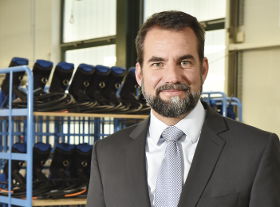 With the retirement of the long-term managing director Hanno Pünjer in December, Bert Gausepohl took over the sole management of the company. The graduate lawyer has been working for the company for many years. Among other things, he headed the American subsidiary PAM and, in 2014, was appointed second managing director beside Hanno Pünjer.
With the retirement of the long-term managing director Hanno Pünjer in December, Bert Gausepohl took over the sole management of the company. The graduate lawyer has been working for the company for many years. Among other things, he headed the American subsidiary PAM and, in 2014, was appointed second managing director beside Hanno Pünjer.
Move into the new building
In May, the new building “Hinterm Sielhof 25” was inaugurated. Employees can work in a relaxed atmosphere on two floors. Modern ventilation and heating systems ensure a perfect climate at all times and protect the environment. As part of the conversion work, production, laboratory and logistics were also modernized.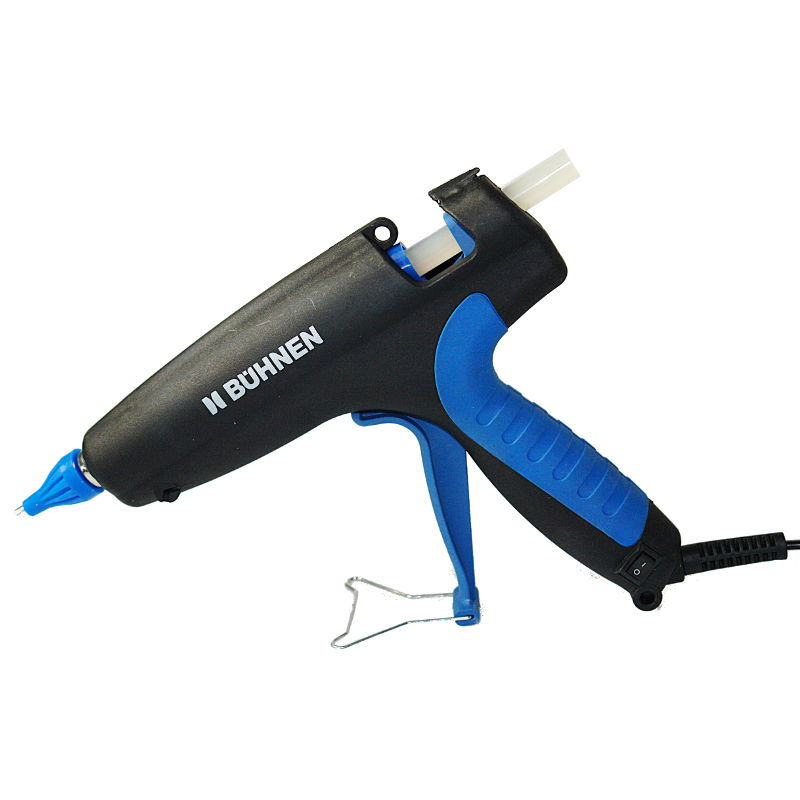 Introduction of HB 191
Introduction of HB 191
The equipment lines of the mechanical glue guns were further redesigned in 2016. The HB 191 replaced the existing HB 190. A special feature of the hot glue gun is the patented three-position stand, which makes it possible to adjust the parking position to the respective working methods. At the same time, the handling has been optimized for use by both left and right handers. Hungarian homepage and catalogue
In July, the Hungarian version of the homepage went online. With this, our customers in Hungary now have the opportunity of directly accessing information on the company and its products. This is accompanied by the respective catalogue.Change in the Management
 With the retirement of the long-term managing director Hanno Pünjer in December, Bert Gausepohl took over the sole management of the company. The graduate lawyer has been working for the company for many years. Among other things, he headed the American subsidiary PAM and, in 2014, was appointed second managing director beside Hanno Pünjer.
With the retirement of the long-term managing director Hanno Pünjer in December, Bert Gausepohl took over the sole management of the company. The graduate lawyer has been working for the company for many years. Among other things, he headed the American subsidiary PAM and, in 2014, was appointed second managing director beside Hanno Pünjer.2015
HB 6000 – the second generation
The HB 6000 tank system developed in 2008 is replaced by an improved and enhanced version. The HB 6000-series tank systems are fitted with piston pumps and 5, 10, 20 or 35-litre tanks and up to six hose connections, depending on customers’ needs. The HB 6000 series devices boast high performance, simple handling and an easy-to-use temperature control with display.Introduction of HB 181
The newly developed HB 181 mechanical hand pistol replaces the previous HB 180 model. The three possible mounting operations are successfully registered for a patent. With the HB 181, BÜHNEN offers a powerful, small and easy to manage device that has many more applications than just for florists.Takeover of the Operations of our Former Subsidiary in Austria
In July, BÜHNEN wholly acquired the sales operations of adhesive systems in Austria, Slovenia, Slovakia, the Czech Republic and Hungary from its former subsidiary company in Vienna, Heinz Bühnen GmbH & Co. KG. Austria and Slovenia are supervised by two of our own staff, the Czech Republic and Slovakia by BÜHNEN Polska in Wroclaw, and the Hungarian operations by an exclusive representative.Start of Construction on New Offices
The building work on the new offices on our Bremen site began in July. The building work will probably be completed in April 2016. The new building is a sustainable investment in improved working spaces and a clear commitment to our “Hinterm Sielhof” site in Bremen.Termolan in the BÜHNEN Group
Bühnen International GmbH acquired Termolan Sp. z.o.o. in Poland and Termolan CZ s.r.o in the Czech Republic from the Termolan founders in December, and in doing so became the market-leading company for hot melt adhesives in Central and Eastern Europe.2014
Launch of new home page
The newly designed home page is unveiled with a new, fresh layout and user-friendly menu navigation. A much-improved search function is also available that provides customers with their results even more quickly. The navigation has a better overall structure, making information much easier to find. A newly created glossary helps customers with terminology from the industry. The simple method of contact opens up new ways to get in touch with us. The products are more clearly arranged and include all the important technical data. Product and application videos are available for some products, with more videos being added all the time. A selection of suitable adhesives are presented for every device. A range of appropriate adhesives and suitable application technology relating to various application areas is also displayed.2013
With the HB 910, BÜHNEN offers a new, particularly ergonomic handheld device for hot-melt adhesive application. The very light device with 360° rotation, which has been produced for track and spray application, allows for convenient operation coupled with minimal effort. With a spray air line laid directly in the hose, the HB 910 benefits from a reduction in temperature in the handheld device which, among other things, protects the adhesive. The rubberised handle and long trigger guarantee safe working in both single- and two-handed modes of operation, eliminating the risk of the hand slipping off and, with its insulation, providing protection from burns. Thanks to its smaller cross-section, the handle is also ideal for people with small hands.
Entry into social networks
At the start of 2013, BÜHNEN became active on social networks and uses them to interact with company customers and partners. Innovations and information about melt adhesives and application devices are showcased here.2012
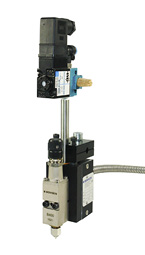 BÜHNEN greatly expands its market share, especially in the packaging industry, through the success of the oxidation-resistant adhesives for packaging. Sales of the BÜHNEN pressure-sensitive hot-melt adhesives (PSA) also see extraordinary growth in comparison to the market growth rate.
BÜHNEN greatly expands its market share, especially in the packaging industry, through the success of the oxidation-resistant adhesives for packaging. Sales of the BÜHNEN pressure-sensitive hot-melt adhesives (PSA) also see extraordinary growth in comparison to the market growth rate. The existing series of application heads is expanded to include the new HB 20 HB (bead head) and HB 30 (spray head) hot-melt adhesive application heads. These heads are generally only equipped with MAC valves, which are regarded around the world as being especially reliable. They are characterised by their absolute dependability and very high heat resistance. The wide construction of the bead head ensures an excellent transfer of temperature to the forward screwed modules and thus prevents stringing during the application of the adhesive. The broad design of the spray application head also improves the application of the adhesive. The mount for both types of application heads is moved upwards to facilitate the fastening of the application heads in a host machine.
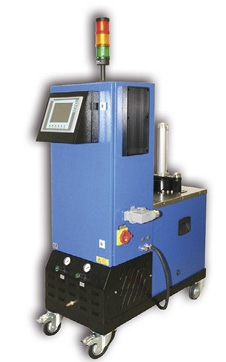
The bag melters of the 4000 series are redesigned. Temperature setting and internal processes in the device are exclusively controlled by PLC. The accessibility for service and maintenance work is also optimised. Control system modifications eliminate the need for a fill level sensor in the reservoir.
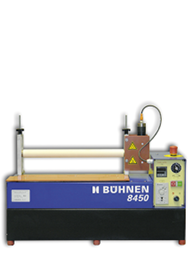 The roller application devices in the 8000 series are equipped with a digital temperature controller and freely adjustable pressing rollers, some with a separate drive. These devices are now also available in a tabletop version.
The roller application devices in the 8000 series are equipped with a digital temperature controller and freely adjustable pressing rollers, some with a separate drive. These devices are now also available in a tabletop version.2011
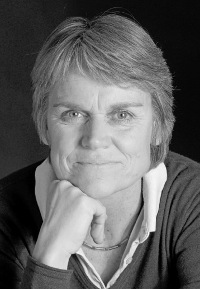 Ilse Bühnen passes away at the age of 89. Her share of the company stays in the family: Constance Wriedt, née Bühnen, becomes the majority shareholder and maintains continuity in the group.
Ilse Bühnen passes away at the age of 89. Her share of the company stays in the family: Constance Wriedt, née Bühnen, becomes the majority shareholder and maintains continuity in the group. The positive development in the Netherlands and Belgium prompts BÜHNEN to expand by founding BÜHNEN Benelux BV and hiring an additional employee to concentrate on the central and northern regions of the Netherlands.
The positive development in the Netherlands and Belgium prompts BÜHNEN to expand by founding BÜHNEN Benelux BV and hiring an additional employee to concentrate on the central and northern regions of the Netherlands.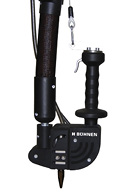 The soaring price of raw materials for EVA adhesives helps the oxidation-resistant hot-melt adhesives in the avenia series to greatly expand their market share in the packaging industry.
The soaring price of raw materials for EVA adhesives helps the oxidation-resistant hot-melt adhesives in the avenia series to greatly expand their market share in the packaging industry.2010
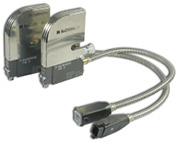
 The HB 11 micro application head that was presented in 2010 and is part of the one4all series is still considered to be the smallest bead application head in the world. It is primarily characterised by its speed and also has a very compact design. With up to 200 cycles per second and a magnetic valve with a reaction time of max. 3 milliseconds, it continues to set standards to this day.
The HB 11 micro application head that was presented in 2010 and is part of the one4all series is still considered to be the smallest bead application head in the world. It is primarily characterised by its speed and also has a very compact design. With up to 200 cycles per second and a magnetic valve with a reaction time of max. 3 milliseconds, it continues to set standards to this day.2009
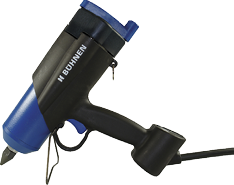 BÜHNEN is able to offer devices for nearly every type of application up until the end of 2008. The only products yet to be offered are roller application devices. The advantage of the newly introduced 8000 series for manual application is primarily its ability to quickly and easily coat large surfaces of mostly stamped materials with hot-melt adhesive.
BÜHNEN is able to offer devices for nearly every type of application up until the end of 2008. The only products yet to be offered are roller application devices. The advantage of the newly introduced 8000 series for manual application is primarily its ability to quickly and easily coat large surfaces of mostly stamped materials with hot-melt adhesive.The HB 710 is introduced to the market as a continuation of the HB 700 series. It is lighter and easier to service.
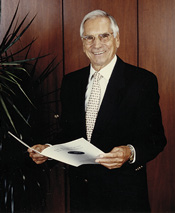 Heinz Bühnen passes away at the age of 89. His wife Ilse Bühnen retains ownership of the shares.
Heinz Bühnen passes away at the age of 89. His wife Ilse Bühnen retains ownership of the shares. Direct business is expanded in the Netherlands and Belgium in order to improve the service to customers there. BÜHNEN initially has one employee there. The logistics are managed from Bremen.
Direct business is expanded in the Netherlands and Belgium in order to improve the service to customers there. BÜHNEN initially has one employee there. The logistics are managed from Bremen.2008
The HB 325 replaces the HB 320. The first pneumatic application device that can handle 18 mm sticks, the HB 350, is presented. 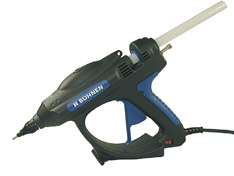
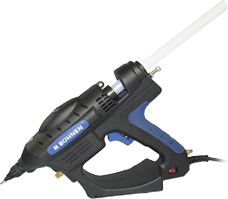
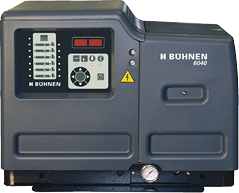
 After careful analysis BÜHNEN decides to work the Polish market directly. BÜHNEN Polska Sp. z o.o. is founded in in Wrocław (Breslau) and initially employs 7 workers. Two years later an eighth worker, responsible for the Czech Republic and Slovakia, joins the team. Customers are initially supplied from Bremen and later also from Wroclaw. With this move the company continues its strategy of investing in markets with strong potential and working them with the company’s own team in order to be able to ensure the greatest possible level of customer proximity.
After careful analysis BÜHNEN decides to work the Polish market directly. BÜHNEN Polska Sp. z o.o. is founded in in Wrocław (Breslau) and initially employs 7 workers. Two years later an eighth worker, responsible for the Czech Republic and Slovakia, joins the team. Customers are initially supplied from Bremen and later also from Wroclaw. With this move the company continues its strategy of investing in markets with strong potential and working them with the company’s own team in order to be able to ensure the greatest possible level of customer proximity.



 After careful analysis BÜHNEN decides to work the Polish market directly. BÜHNEN Polska Sp. z o.o. is founded in in Wrocław (Breslau) and initially employs 7 workers. Two years later an eighth worker, responsible for the Czech Republic and Slovakia, joins the team. Customers are initially supplied from Bremen and later also from Wroclaw. With this move the company continues its strategy of investing in markets with strong potential and working them with the company’s own team in order to be able to ensure the greatest possible level of customer proximity.
After careful analysis BÜHNEN decides to work the Polish market directly. BÜHNEN Polska Sp. z o.o. is founded in in Wrocław (Breslau) and initially employs 7 workers. Two years later an eighth worker, responsible for the Czech Republic and Slovakia, joins the team. Customers are initially supplied from Bremen and later also from Wroclaw. With this move the company continues its strategy of investing in markets with strong potential and working them with the company’s own team in order to be able to ensure the greatest possible level of customer proximity.2007
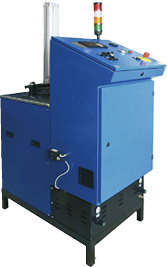 So-called bag melters are developed in order to operate reactive hot-melt adhesives without interruption and without requiring the use of the very expensive tandem drum unloaders. The bag melters are also advantageous in that they allow the adhesive to be gently melted thanks to a reservoir that is constantly filled with liquid hot-melt adhesive. A new foil bag can be placed into the tank pipe during on-going operations, thus allowing production to continue without interruption. There is also very little residual waste because there is almost no residual adhesive in the empty bags.
So-called bag melters are developed in order to operate reactive hot-melt adhesives without interruption and without requiring the use of the very expensive tandem drum unloaders. The bag melters are also advantageous in that they allow the adhesive to be gently melted thanks to a reservoir that is constantly filled with liquid hot-melt adhesive. A new foil bag can be placed into the tank pipe during on-going operations, thus allowing production to continue without interruption. There is also very little residual waste because there is almost no residual adhesive in the empty bags.2005
The HB 230 E, featuring a micro-processor-controlled temperature setting, is introduced that year. It has been developed primarily for use with polyamide sticks, specifically for applications in the electrical industry. The HB 700 replaces the successful Powerline series the same year. The HB 320, a high performance stick gun for 18 mm sticks, is also developed. 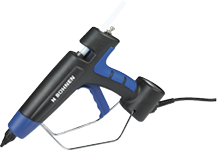
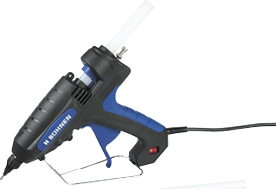
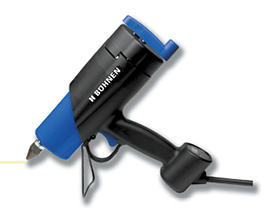



2004
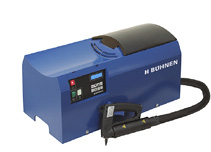
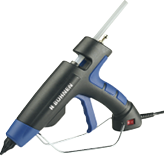 The introduction of the HB 5010 brings onto the market a device whose design and features are once again geared in all respects to ergonomic needs and ease of use.
The introduction of the HB 5010 brings onto the market a device whose design and features are once again geared in all respects to ergonomic needs and ease of use.The group’s focus is solely directed towards the core business with hot-melt adhesive systems. All company activities are consolidated in Bremen. The activities in the packaging industry undergo massive expansion with the new EVA and PO-based hot-melt adhesives. BÜHNEN taps into the business of making compatible replacement parts for application devices from Nordson, Robatech and ITW Dynatec with the one4all series that is unveiled for the first time this year.
2003
 The present managing director, Hanno Pünjer, joins the company and initially purchases 25% of the shares. The majority of the shares remain with the Bühnen family.
The present managing director, Hanno Pünjer, joins the company and initially purchases 25% of the shares. The majority of the shares remain with the Bühnen family.2002
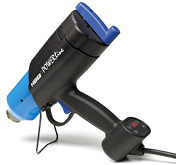 HBB introduces a new generation of manual pneumatic adhesive application devices. The Powerline replaces the HB 500 series and is distinguished by its light weight, optimised ergonomics and good melting performance.
HBB introduces a new generation of manual pneumatic adhesive application devices. The Powerline replaces the HB 500 series and is distinguished by its light weight, optimised ergonomics and good melting performance.2001
Oxidation-resistant, PO-based hot-melt adhesives are introduced. These adhesives, later to be sold under the name avenia, are especially well suited for packaging applications and, thanks to their oxidation resistance, also extend the application technology’s service life.
2000
Special requirements in the automotive industry lead to the development of in-house formulas for polyolefin-based reactive hot-melt adhesives that do not require labelling. They feature unique thermal properties and offer an advantage over PUR adhesives, particularly when working with untreated PP surfaces.
1998
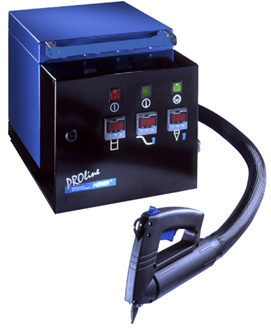 HBB presents the newly developed Proline tank system with a hand-held device. A new generation of hand-held devices that set new standards in terms of handling is created in cooperation with a renowned designer.
HBB presents the newly developed Proline tank system with a hand-held device. A new generation of hand-held devices that set new standards in terms of handling is created in cooperation with a renowned designer.1996
The HB 180 and HB 190, a set of special stick guns primarily designed for use by florists and decorators, are introduced in 1996. 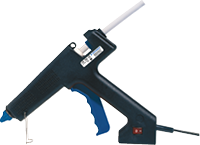

1995
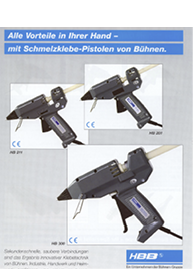 In the mid-1990s the selection of stick guns for industrial use is expanded to include a higher performance series: the HB 201, HB 211 and HB 300 are introduced to the market.
In the mid-1990s the selection of stick guns for industrial use is expanded to include a higher performance series: the HB 201, HB 211 and HB 300 are introduced to the market.1994
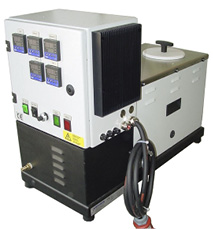 "A new era begins at Bühnen with the HB 4000 series hot-melt adhesive tank systems. Both gear pump and piston pump devices can now be produced for all types of hot-melt adhesives as a kind of modular design system."
"A new era begins at Bühnen with the HB 4000 series hot-melt adhesive tank systems. Both gear pump and piston pump devices can now be produced for all types of hot-melt adhesives as a kind of modular design system."1993
Heinz Bühnen enters a new business field: lubrication systems. Lubrication is used on all components with surfaces that permanently rub against each other. This protects the material’s surface and minimises wear. It is most widely used in the automotive and fitting industries. The Bühnen Group acquires HELFER & Co. KG, a long-standing supplier of the company and global leader in auto-feed screwdriver technology.
1991
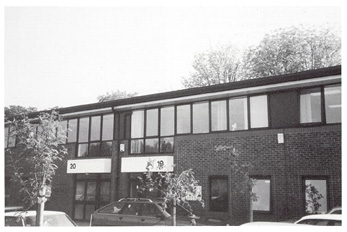 Heinrich Bühnen Ltd. is founded in Basingstoke, England, on 1 September 1991. The sales programme in England encompasses the entire HBB range.
Heinrich Bühnen Ltd. is founded in Basingstoke, England, on 1 September 1991. The sales programme in England encompasses the entire HBB range.1989
Heinrich Bühnen KG unveils the HB 3000, the first hot-melt adhesive application device with a gear pump powered directly by a rotary magnet motor. This motor is hailed as extremely robust and can function without complications even in ambient temperatures of up to 80°C. The devices are also very service-friendly.
1988
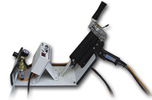 The first pneumatic manual application device to use cartridges, the HB 500 K, is launched. The HB 500 K is the first device which allows the manual application of reactive hot-melt adhesives. The first reactive hot-melt adhesives are developed and introduced at the same time as the cartridge device, primarily for applications in the timber industry.
The first pneumatic manual application device to use cartridges, the HB 500 K, is launched. The HB 500 K is the first device which allows the manual application of reactive hot-melt adhesives. The first reactive hot-melt adhesives are developed and introduced at the same time as the cartridge device, primarily for applications in the timber industry.1986
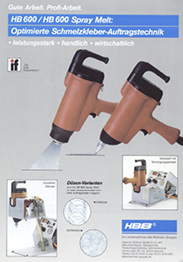 The HB 600 is a device whose ergonomic design and ease of operation gear it in all respects to the requirements of the users. Its development marks the first time an industrial designer has been called on to design a product for the adhesives market.
The HB 600 is a device whose ergonomic design and ease of operation gear it in all respects to the requirements of the users. Its development marks the first time an industrial designer has been called on to design a product for the adhesives market.1985
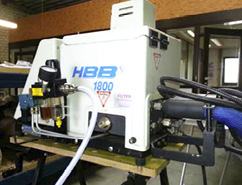 In the mid 1980s HBB unveils a true innovation in hot-melt adhesive application equipment: the so-called 2000 series consists of the HB 1800, HB 2000, HB 2100 and HB 2200. These devices are equipped with either gear pumps or piston pumps and tanks ranging from 4 up to 48 litres in size. The gear pumps are powered by pneumatic motors. The housings of the devices in the 2000 series are made of plastic, a design element that will not be used again for some time. One of the other highlights is the control cabinet with temperature control which is greeted with enthusiasm not just because of its design, which is unique for the time. It can also be plugged in electrically and easily disconnected from the device when necessary.
In the mid 1980s HBB unveils a true innovation in hot-melt adhesive application equipment: the so-called 2000 series consists of the HB 1800, HB 2000, HB 2100 and HB 2200. These devices are equipped with either gear pumps or piston pumps and tanks ranging from 4 up to 48 litres in size. The gear pumps are powered by pneumatic motors. The housings of the devices in the 2000 series are made of plastic, a design element that will not be used again for some time. One of the other highlights is the control cabinet with temperature control which is greeted with enthusiasm not just because of its design, which is unique for the time. It can also be plugged in electrically and easily disconnected from the device when necessary.1983
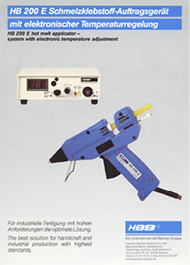
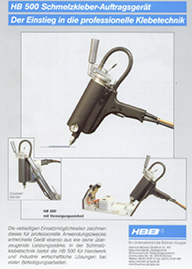 The first pneumatic hand gun for applying hot-melt adhesive as a spray is launched: the HB 500E features an electronic temperature control and can also be used with the polyamide hot-melt adhesives that were also introduced in the same year. The polyamide-based hot-melt adhesives are used primarily in the electrical industry. HBB also unveils the HB 200 E, a stick gun featuring an electronic temperature control in a separate housing and able to process high-temperature hot-melt adhesives.
The first pneumatic hand gun for applying hot-melt adhesive as a spray is launched: the HB 500E features an electronic temperature control and can also be used with the polyamide hot-melt adhesives that were also introduced in the same year. The polyamide-based hot-melt adhesives are used primarily in the electrical industry. HBB also unveils the HB 200 E, a stick gun featuring an electronic temperature control in a separate housing and able to process high-temperature hot-melt adhesives.1982
Also in the early 1980s, Heinrich Bühnen KG unveils the first hot-melt adhesive tank systems with a gear pump. The HB 600, HB 700/750 and HB 800/850 series feature a simple design: an alternating current motor powers the gear pump using a chain drive. Plug-in resistors are used to regulate the temperature. There is a basic pre-set temperature which can be regulated to the desired temperature by exchanging plug-in resistors on the circuit board in the control unit.
1981
 The PAM Fastening Technology, Inc. subsidiary is founded in Charlotte, North Carolina (USA) for the purpose of providing better advice and support to customers in the United States. It offers the entire range of Heinrich Bühnen KG products. The company is thus able to offer the high level of service expected in the USA.
The PAM Fastening Technology, Inc. subsidiary is founded in Charlotte, North Carolina (USA) for the purpose of providing better advice and support to customers in the United States. It offers the entire range of Heinrich Bühnen KG products. The company is thus able to offer the high level of service expected in the USA.1980
The successful HB 5 is replaced by the HB 500, a new pneumatic manual application device. The HB 500 features a new, patented air supply and exhaust ventilation system and is more powerful than the HB 5.
1979
In the course of its continuous research, Heinrich Bühnen KG develops the revolutionary spray application and registers it for a patent. Spray application permits hot-melt adhesives to be economically applied to large surfaces without direct contact.
1976

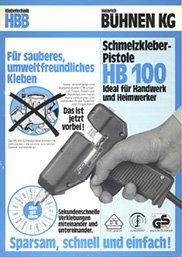 The first stick gun, the HB 100, is launched in Germany. It is followed by others, such as the Klebe-Colt. At the same time, the first 42mm PO adhesive cartridges are developed for the construction industry and the first EVA adhesives in the form of sticks and as granules for the packing industry. A production line is set up specifically for the production of the cartridges.
The first stick gun, the HB 100, is launched in Germany. It is followed by others, such as the Klebe-Colt. At the same time, the first 42mm PO adhesive cartridges are developed for the construction industry and the first EVA adhesives in the form of sticks and as granules for the packing industry. A production line is set up specifically for the production of the cartridges.1975
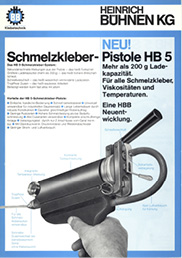 In the mid-1970s comes the move towards the use of hot-melt adhesives and the development of the corresponding applicators. This new business field receives more and more attention and is continuously expanded. New service elements are added until the field ultimately becomes the core business area. As developments in hot-melt adhesives are continuously paving the way for new applications, sectors like the automotive, construction, floristry, electronics and packaging industries are soon lining up to buy a wide range of hot-melt adhesives and equipment.
In the mid-1970s comes the move towards the use of hot-melt adhesives and the development of the corresponding applicators. This new business field receives more and more attention and is continuously expanded. New service elements are added until the field ultimately becomes the core business area. As developments in hot-melt adhesives are continuously paving the way for new applications, sectors like the automotive, construction, floristry, electronics and packaging industries are soon lining up to buy a wide range of hot-melt adhesives and equipment.1969

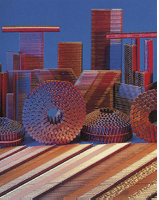 Deutsche Senco Industrie-Erzeugnisse GmbH & Co. KG was founded by SENCO (Cincinnati/Ohio, USA) and the Bühnen Group in 1969. It is a technically advanced provider of nailing and stapling equipment supplies. Industrial staples and nails are prepared strip by strip on special machines for use in SENCO equipment. This brings added precision to the magazines since quality assurance is a high priority at Deutsche SENCO. The strip nails are also exported to other European countries.
Deutsche Senco Industrie-Erzeugnisse GmbH & Co. KG was founded by SENCO (Cincinnati/Ohio, USA) and the Bühnen Group in 1969. It is a technically advanced provider of nailing and stapling equipment supplies. Industrial staples and nails are prepared strip by strip on special machines for use in SENCO equipment. This brings added precision to the magazines since quality assurance is a high priority at Deutsche SENCO. The strip nails are also exported to other European countries.1968
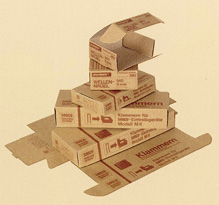
 At the end of the 1960s, the Bühnen Group finds itself in need of a reliable supplier for printed materials and packaging solutions for its products. The group purchases a small printing works in Bremen-Grambke that has been supplying the group but is now facing bankruptcy. Bühnen gives the small team of employees at the printing shop work, confidence in their future and a new company name: ASCO, the acronym for Anne, Stephan and Constance, Heinz Bühnen’s children.
At the end of the 1960s, the Bühnen Group finds itself in need of a reliable supplier for printed materials and packaging solutions for its products. The group purchases a small printing works in Bremen-Grambke that has been supplying the group but is now facing bankruptcy. Bühnen gives the small team of employees at the printing shop work, confidence in their future and a new company name: ASCO, the acronym for Anne, Stephan and Constance, Heinz Bühnen’s children.1961
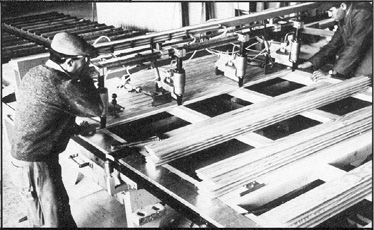 "Thanks to the company’s entrepreneurial instinct, customers are first offered mechanical nailing and stapling tools and then tools that operate with compressed air. The manually operated equipment initially proves its worth in the furniture industry and later takes hold in many other sectors."
"Thanks to the company’s entrepreneurial instinct, customers are first offered mechanical nailing and stapling tools and then tools that operate with compressed air. The manually operated equipment initially proves its worth in the furniture industry and later takes hold in many other sectors."1958
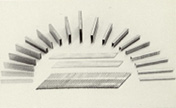 In 1958, Senco Heinz Bühnen KG (renamed Deutsche Senco Industrieerzeugnisse GmbH & Co. KG in 1969) is founded for the manufacture of industrial staples, magazined nails and double nails. The company supplies to customers in Germany, Europe, Africa, Australia and the Far East. Nail and stapling units made by the Heinrich Bühnen KG machine factory are likewise used on every continent. As a licensee of the international SENCO organisation, this turns the Bühnen Group into a major player in the development of new nailing and stapling methods used in trade and industry.
In 1958, Senco Heinz Bühnen KG (renamed Deutsche Senco Industrieerzeugnisse GmbH & Co. KG in 1969) is founded for the manufacture of industrial staples, magazined nails and double nails. The company supplies to customers in Germany, Europe, Africa, Australia and the Far East. Nail and stapling units made by the Heinrich Bühnen KG machine factory are likewise used on every continent. As a licensee of the international SENCO organisation, this turns the Bühnen Group into a major player in the development of new nailing and stapling methods used in trade and industry.1956
 Heinz Bühnen KG, a subsidiary founded in 1956, takes over the sale of SENCO’s pneumatic nailing and stapling tools in Germany.
Heinz Bühnen KG, a subsidiary founded in 1956, takes over the sale of SENCO’s pneumatic nailing and stapling tools in Germany.1953
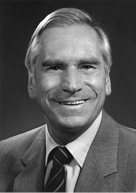 In 1953, Heinz Bühnen, Heinrich’s son, takes over the company. With him comes an innovation in stapling technology that is used primarily in the upholstery furniture industry. With this new technology, the company is able to join materials at an unrivalled speed. The company enters into an exclusive cooperation agreement with the US-based SENCO company, the leading manufacturer of pneumatic fastening systems. The company’s client base grows very rapidly from this point on.
In 1953, Heinz Bühnen, Heinrich’s son, takes over the company. With him comes an innovation in stapling technology that is used primarily in the upholstery furniture industry. With this new technology, the company is able to join materials at an unrivalled speed. The company enters into an exclusive cooperation agreement with the US-based SENCO company, the leading manufacturer of pneumatic fastening systems. The company’s client base grows very rapidly from this point on.1935
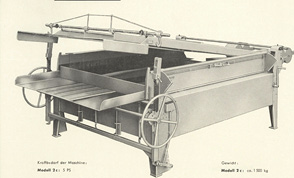 From 1935 onwards, the company no longer offers repair work for other businesses. Its sole focus is now on the manufacturing of upholstery machines. The machines are also exported to various European countries up until 1938.
From 1935 onwards, the company no longer offers repair work for other businesses. Its sole focus is now on the manufacturing of upholstery machines. The machines are also exported to various European countries up until 1938.1922
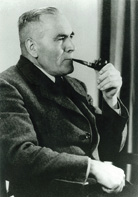 Heinrich Bühnen, a metal worker by trade, opens his own small workshop in Bremen on 3 August 1922. Coffee roasters turn to him for their machine repairs. He quickly develops a reputation for his excellent talent and skills, and his workshop soon becomes a factory specialising in the manufacturing and repair of upholstery machines.
Heinrich Bühnen, a metal worker by trade, opens his own small workshop in Bremen on 3 August 1922. Coffee roasters turn to him for their machine repairs. He quickly develops a reputation for his excellent talent and skills, and his workshop soon becomes a factory specialising in the manufacturing and repair of upholstery machines.